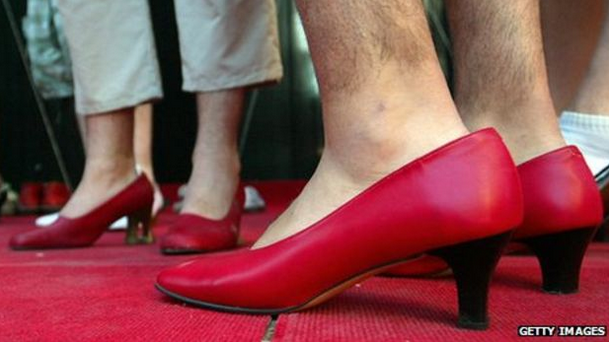|
Once upon a time, men commonly wore high-heeled shoes. Not necessarily like those pictured here, but definitely big, chunky, elevating heels. This interesting BBC story asks: why did men stop wearing them? (As a rule, that is. In certain contexts, of course, some men still do.)
Participation! Read the story and consider the stated reasons for this change. Put this into conversation with Judith Butler's ideas about gender performativity. What is it about the structure of a shoe that signals gender? How do other elements of fashion contribute to gender construction?
7 Comments
The above song, a one-hit wonder from 1971, is a particularly historically and culturally situated lyrical consideration of signs — in the denotative sense, surely (actual posts and placards containing written messages), but also in various connotative senses.
Semiotics, as outlined in the Danesi reading, can be a lot to get your head around. If you'd like more in-depth background on signs, codes, texts, and more, look to this excellent primer, "Semiotics for Beginners," particularly parts 1, 2, 7, and 9. Participation! Consider this image below, indicating the appropriate gender of restroom facilities. Does it look more like a man than a woman? Why? What is indexed? What is symbolized? This week you'll complete the first of the course's two group assignments, per the syllabus. Here's a written prompt for that assignment ...
In the Wednesday section this week, Sarp proposed an interesting question in light of some of this week's topics: Where's the communication (from whom to whom) when we talk to ourselves?
Directly related to our first reading, check out "The Story of Mike Phillips," an episode of "This American Life" (below). Like Jean-Dominique Bauby, Phillips is mostly immobilized and learns to communicate by blinking his eyes and other delicate movements. Phillips, however, benefits from a unique technological system that helps him peck out the individual letters needed for textual communication. He also gets some help from Johnny Depp ... Participation! Consider how the issues raised in this video reflect the challenges and changes in recent developments within communication, particularly from the perspective of UCSD's comm dept. (situated practices, social formations, and interpretive strategies).
We'll talk early on about some strategies for reading effectively — and taking notes about what you read (very important to do!).
For now, peruse these excellent guides for perfecting your university-level reading process: — "Advice for Students: How to Read Like a Scholar" — "How to Read in College" — "Critical Reading in the Social Sciences" Participation! Use the comments here to post helpful examples and tips from your reading process, things you've learned by experience thus far. Feel free to include screenshots of annotated pages, notes, etc. |
COMM 10
|


 RSS Feed
RSS Feed